BSBCOM603: Compliance Management Systems in Leadership Diploma
VerifiedAdded on 2023/06/04
|11
|2149
|80
Report
AI Summary
This report provides a comprehensive overview of compliance requirements for organizations, particularly focusing on a charity care organization. It details internal, external, and industry-specific compliance measures, highlighting the importance of adhering to these requirements to avoid risks and penalties. The report also explores compliance management systems, including board oversight, compliance programs, and audits, emphasizing the need for trained personnel and a well-defined implementation plan. It covers the establishment of a compliance program, including identifying its purpose, understanding the organizational culture, and setting goals and objectives. The report concludes by underscoring the benefits of a robust compliance system in managing risks, promoting transparency, and improving overall organizational performance. Desklib provides access to this and other solved assignments for students.

DIPLOMA OF LEADERSHIP&MANAGEMENT 1
Compliance Requirements
By (Name)
Course
Instructor’s Name
Institutional Affiliation
The City and State
The Date
N.B
I did all the three but combined and continuous
I differentiated by using upper-case headings
Compliance Requirements
By (Name)
Course
Instructor’s Name
Institutional Affiliation
The City and State
The Date
N.B
I did all the three but combined and continuous
I differentiated by using upper-case headings
Paraphrase This Document
Need a fresh take? Get an instant paraphrase of this document with our AI Paraphraser
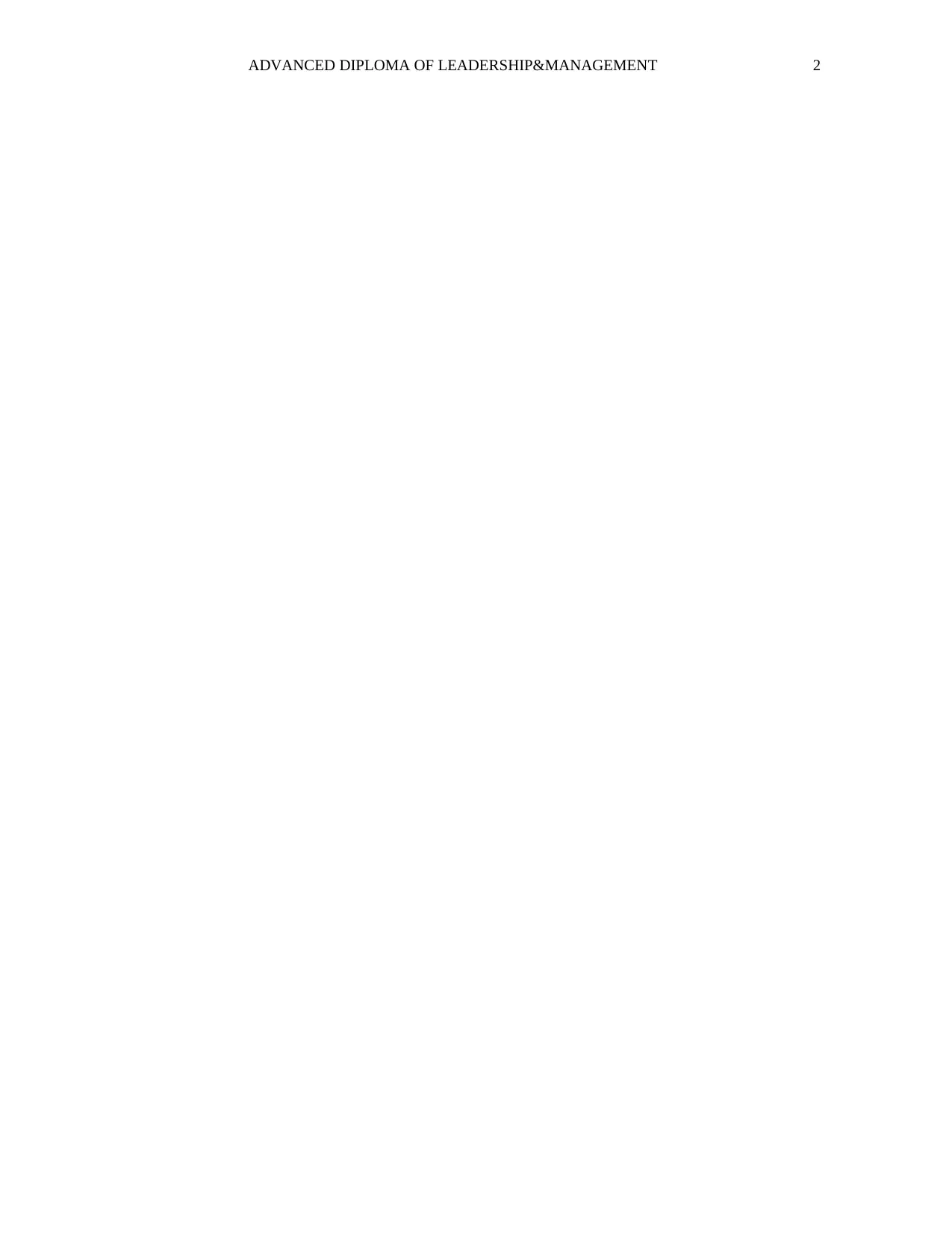
ADVANCED DIPLOMA OF LEADERSHIP&MANAGEMENT 2

ADVANCED DIPLOMA OF LEADERSHIP&MANAGEMENT 3
Introduction
An organization for better management and performance requires a good management
and support structure. Organization as a term is a very essential element for a quality system and
it is closely connected to all the other components of the management model. However,
commitment is required to the regulations within the operational areas. This paper reviews the
requirements for a charity care organization and gives an overview of the compliance
management systems.
COMPLIANCE REQUIREMENTS
For any organization to operate legally, it must comply with particular requirements
concerning the organization’s transactions, safety precautions and also labour practices.
Compliance in general terms means working with the behaviour according to the regulation of
the statutory bodies(Becker, 2014). All the employees should work in accordance and with
regard in abidance of all regulations and the set legal rules, and corporate guidelines. Compliance
requirements can be divided into three categories; internal requirements, external requirements
and industrial requirements.
Internal compliance requirements
Internal measures of compliance are those that are normally required by the government
for any organization to operate. These measures are formed and put in practice by the
organization internally by the upper staff of the organization(Benedek, 2012).
Charity care organizations have strict requirements internally which are comprised of
forming a board of directors, conducting meetings for example initial and yearly meetings of
Introduction
An organization for better management and performance requires a good management
and support structure. Organization as a term is a very essential element for a quality system and
it is closely connected to all the other components of the management model. However,
commitment is required to the regulations within the operational areas. This paper reviews the
requirements for a charity care organization and gives an overview of the compliance
management systems.
COMPLIANCE REQUIREMENTS
For any organization to operate legally, it must comply with particular requirements
concerning the organization’s transactions, safety precautions and also labour practices.
Compliance in general terms means working with the behaviour according to the regulation of
the statutory bodies(Becker, 2014). All the employees should work in accordance and with
regard in abidance of all regulations and the set legal rules, and corporate guidelines. Compliance
requirements can be divided into three categories; internal requirements, external requirements
and industrial requirements.
Internal compliance requirements
Internal measures of compliance are those that are normally required by the government
for any organization to operate. These measures are formed and put in practice by the
organization internally by the upper staff of the organization(Benedek, 2012).
Charity care organizations have strict requirements internally which are comprised of
forming a board of directors, conducting meetings for example initial and yearly meetings of
⊘ This is a preview!⊘
Do you want full access?
Subscribe today to unlock all pages.

Trusted by 1+ million students worldwide
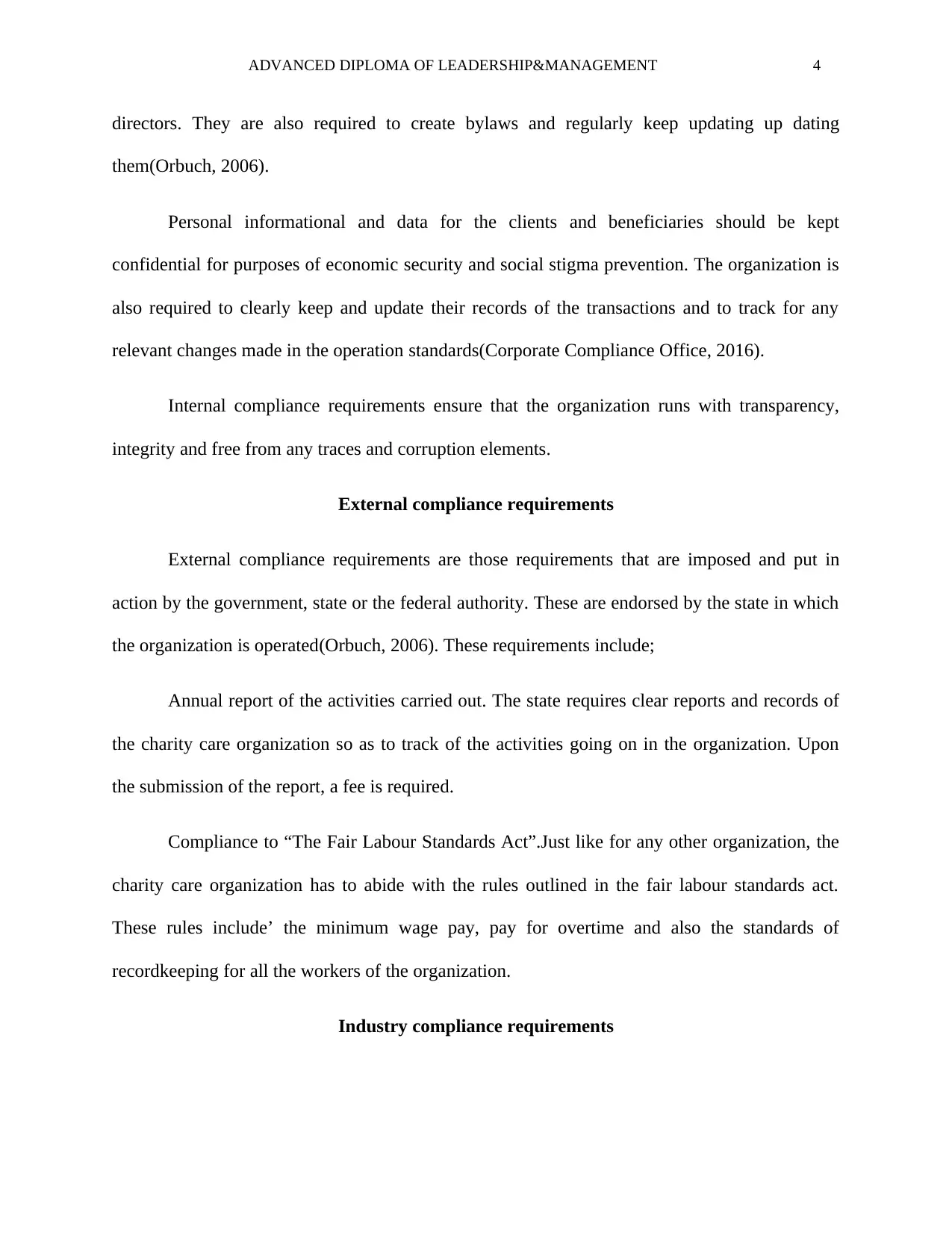
ADVANCED DIPLOMA OF LEADERSHIP&MANAGEMENT 4
directors. They are also required to create bylaws and regularly keep updating up dating
them(Orbuch, 2006).
Personal informational and data for the clients and beneficiaries should be kept
confidential for purposes of economic security and social stigma prevention. The organization is
also required to clearly keep and update their records of the transactions and to track for any
relevant changes made in the operation standards(Corporate Compliance Office, 2016).
Internal compliance requirements ensure that the organization runs with transparency,
integrity and free from any traces and corruption elements.
External compliance requirements
External compliance requirements are those requirements that are imposed and put in
action by the government, state or the federal authority. These are endorsed by the state in which
the organization is operated(Orbuch, 2006). These requirements include;
Annual report of the activities carried out. The state requires clear reports and records of
the charity care organization so as to track of the activities going on in the organization. Upon
the submission of the report, a fee is required.
Compliance to “The Fair Labour Standards Act”.Just like for any other organization, the
charity care organization has to abide with the rules outlined in the fair labour standards act.
These rules include’ the minimum wage pay, pay for overtime and also the standards of
recordkeeping for all the workers of the organization.
Industry compliance requirements
directors. They are also required to create bylaws and regularly keep updating up dating
them(Orbuch, 2006).
Personal informational and data for the clients and beneficiaries should be kept
confidential for purposes of economic security and social stigma prevention. The organization is
also required to clearly keep and update their records of the transactions and to track for any
relevant changes made in the operation standards(Corporate Compliance Office, 2016).
Internal compliance requirements ensure that the organization runs with transparency,
integrity and free from any traces and corruption elements.
External compliance requirements
External compliance requirements are those requirements that are imposed and put in
action by the government, state or the federal authority. These are endorsed by the state in which
the organization is operated(Orbuch, 2006). These requirements include;
Annual report of the activities carried out. The state requires clear reports and records of
the charity care organization so as to track of the activities going on in the organization. Upon
the submission of the report, a fee is required.
Compliance to “The Fair Labour Standards Act”.Just like for any other organization, the
charity care organization has to abide with the rules outlined in the fair labour standards act.
These rules include’ the minimum wage pay, pay for overtime and also the standards of
recordkeeping for all the workers of the organization.
Industry compliance requirements
Paraphrase This Document
Need a fresh take? Get an instant paraphrase of this document with our AI Paraphraser
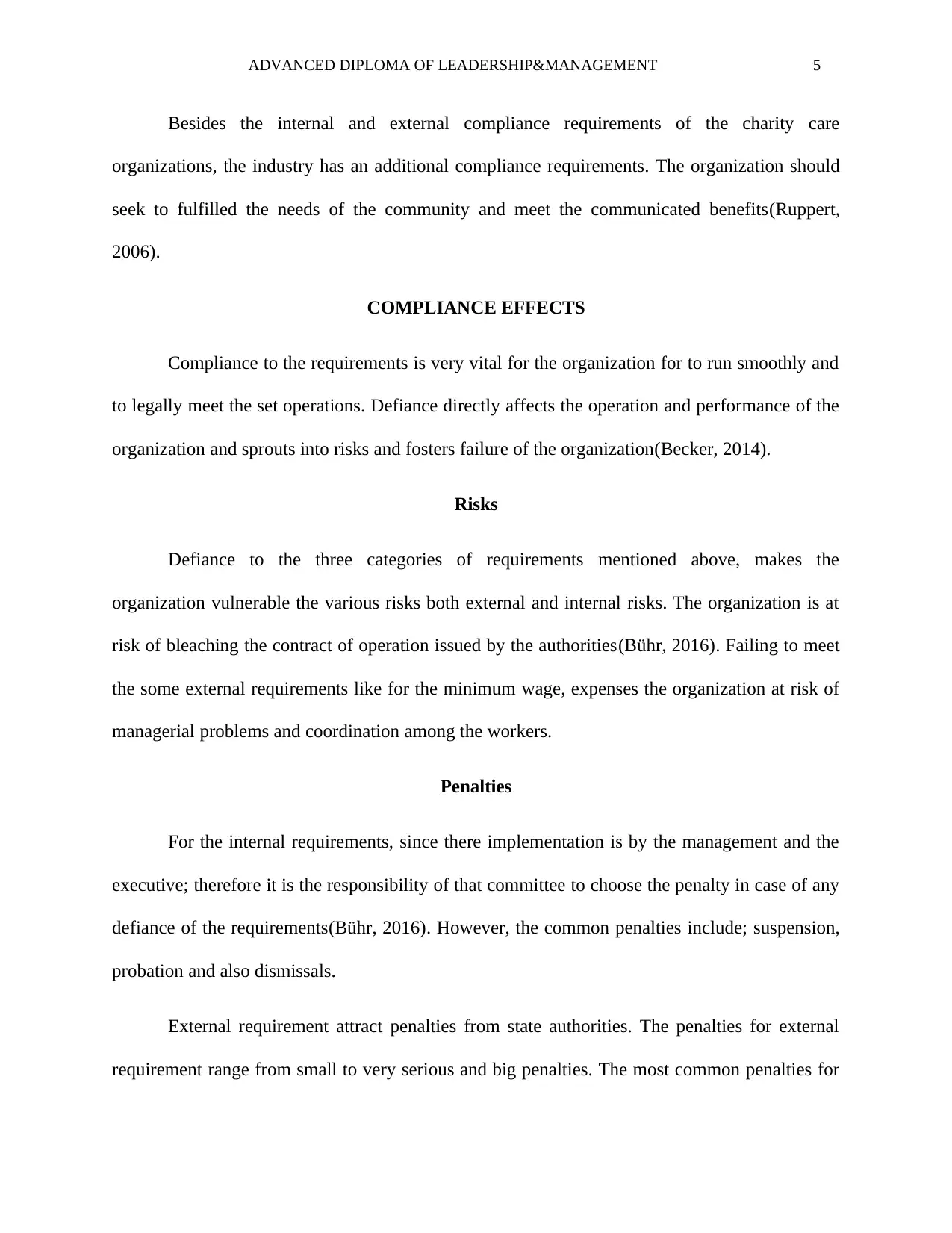
ADVANCED DIPLOMA OF LEADERSHIP&MANAGEMENT 5
Besides the internal and external compliance requirements of the charity care
organizations, the industry has an additional compliance requirements. The organization should
seek to fulfilled the needs of the community and meet the communicated benefits(Ruppert,
2006).
COMPLIANCE EFFECTS
Compliance to the requirements is very vital for the organization for to run smoothly and
to legally meet the set operations. Defiance directly affects the operation and performance of the
organization and sprouts into risks and fosters failure of the organization(Becker, 2014).
Risks
Defiance to the three categories of requirements mentioned above, makes the
organization vulnerable the various risks both external and internal risks. The organization is at
risk of bleaching the contract of operation issued by the authorities(Bühr, 2016). Failing to meet
the some external requirements like for the minimum wage, expenses the organization at risk of
managerial problems and coordination among the workers.
Penalties
For the internal requirements, since there implementation is by the management and the
executive; therefore it is the responsibility of that committee to choose the penalty in case of any
defiance of the requirements(Bühr, 2016). However, the common penalties include; suspension,
probation and also dismissals.
External requirement attract penalties from state authorities. The penalties for external
requirement range from small to very serious and big penalties. The most common penalties for
Besides the internal and external compliance requirements of the charity care
organizations, the industry has an additional compliance requirements. The organization should
seek to fulfilled the needs of the community and meet the communicated benefits(Ruppert,
2006).
COMPLIANCE EFFECTS
Compliance to the requirements is very vital for the organization for to run smoothly and
to legally meet the set operations. Defiance directly affects the operation and performance of the
organization and sprouts into risks and fosters failure of the organization(Becker, 2014).
Risks
Defiance to the three categories of requirements mentioned above, makes the
organization vulnerable the various risks both external and internal risks. The organization is at
risk of bleaching the contract of operation issued by the authorities(Bühr, 2016). Failing to meet
the some external requirements like for the minimum wage, expenses the organization at risk of
managerial problems and coordination among the workers.
Penalties
For the internal requirements, since there implementation is by the management and the
executive; therefore it is the responsibility of that committee to choose the penalty in case of any
defiance of the requirements(Bühr, 2016). However, the common penalties include; suspension,
probation and also dismissals.
External requirement attract penalties from state authorities. The penalties for external
requirement range from small to very serious and big penalties. The most common penalties for

ADVANCED DIPLOMA OF LEADERSHIP&MANAGEMENT 6
defiance of these requirements include payment of certain fees. It can also lead to withholding
the activities of the organization and prohibiting their operation.
Risk minimisation
To minimize the risks involved in compliance to the organizational requirements, the key
plays in the implementation should set strategy of implementation. Monitoring systems should
be set and clearly evaluated(Ruppert, 2006). There should clear coordination between the
organization, the state and employees of the organization.
COMPLIANCE SYSTEMS
A compliance management system is an instrument comprising of policies, processes,
measures, monitoring and analysing programs, and an audit of a compliance function regarding
submission to all applicable rules and regulations. A compliance system is how the organization
comes to learn about their responsibilities of compliance and how to ensure that the employees
understand these compliance responsibilities(Corporate Compliance Office, 2016). The
compliance system also ensures that the organizational requirements are well merged into the
operation of the organization. The system also is to review the organizational operations, to
certify the responsibilities are executed with the requirements all met. It adopts any corrective
actions and updates the materials as necessary.
Effective compliance systems are usually made up of three interlinked and interdependent
components.
i. The board and management oversight. This takes the responsibility of evolving and
controlling compliance systems which meet with the internal compliance requirements.
The success of a compliance system for an organization is dependent on the board.
defiance of these requirements include payment of certain fees. It can also lead to withholding
the activities of the organization and prohibiting their operation.
Risk minimisation
To minimize the risks involved in compliance to the organizational requirements, the key
plays in the implementation should set strategy of implementation. Monitoring systems should
be set and clearly evaluated(Ruppert, 2006). There should clear coordination between the
organization, the state and employees of the organization.
COMPLIANCE SYSTEMS
A compliance management system is an instrument comprising of policies, processes,
measures, monitoring and analysing programs, and an audit of a compliance function regarding
submission to all applicable rules and regulations. A compliance system is how the organization
comes to learn about their responsibilities of compliance and how to ensure that the employees
understand these compliance responsibilities(Corporate Compliance Office, 2016). The
compliance system also ensures that the organizational requirements are well merged into the
operation of the organization. The system also is to review the organizational operations, to
certify the responsibilities are executed with the requirements all met. It adopts any corrective
actions and updates the materials as necessary.
Effective compliance systems are usually made up of three interlinked and interdependent
components.
i. The board and management oversight. This takes the responsibility of evolving and
controlling compliance systems which meet with the internal compliance requirements.
The success of a compliance system for an organization is dependent on the board.
⊘ This is a preview!⊘
Do you want full access?
Subscribe today to unlock all pages.

Trusted by 1+ million students worldwide
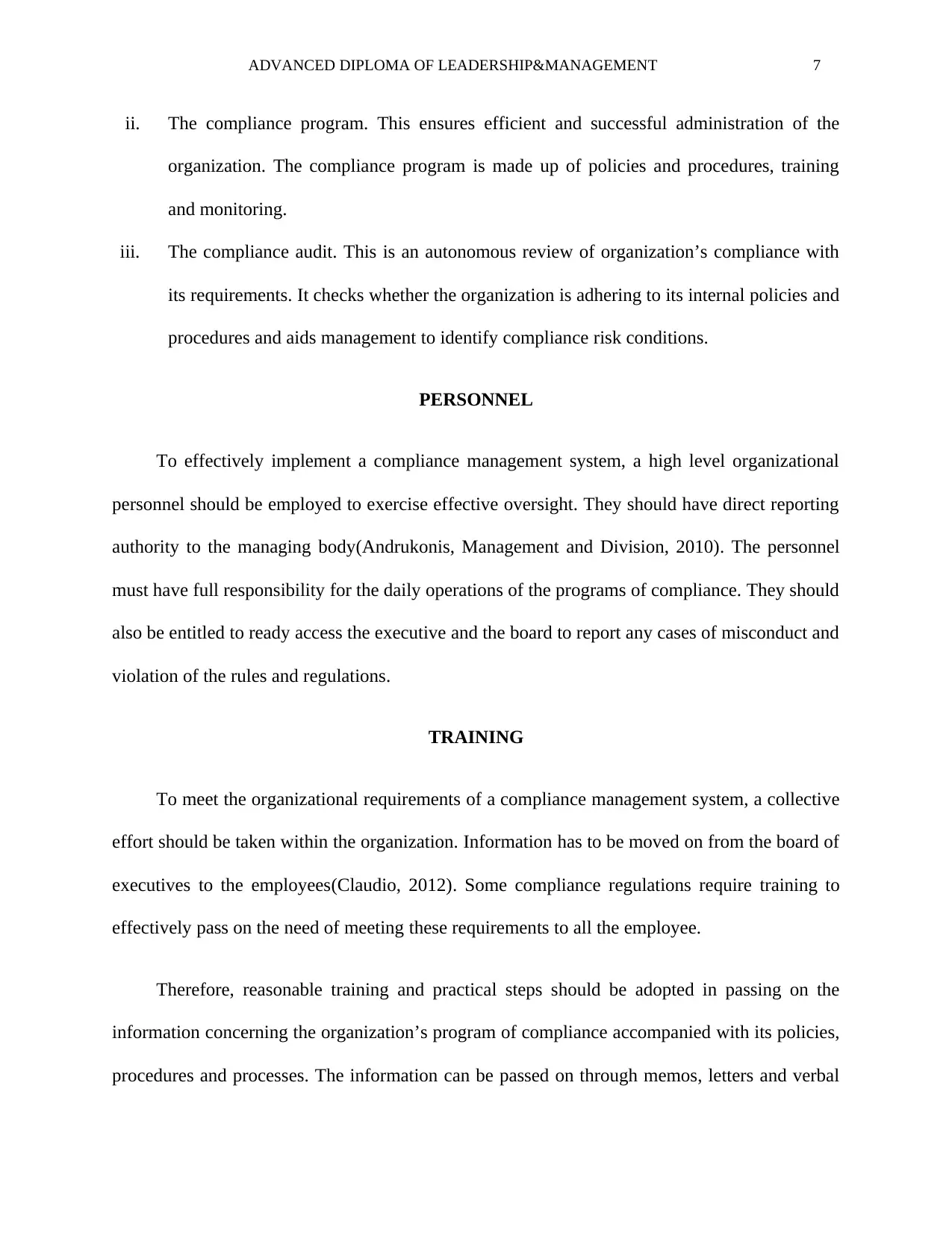
ADVANCED DIPLOMA OF LEADERSHIP&MANAGEMENT 7
ii. The compliance program. This ensures efficient and successful administration of the
organization. The compliance program is made up of policies and procedures, training
and monitoring.
iii. The compliance audit. This is an autonomous review of organization’s compliance with
its requirements. It checks whether the organization is adhering to its internal policies and
procedures and aids management to identify compliance risk conditions.
PERSONNEL
To effectively implement a compliance management system, a high level organizational
personnel should be employed to exercise effective oversight. They should have direct reporting
authority to the managing body(Andrukonis, Management and Division, 2010). The personnel
must have full responsibility for the daily operations of the programs of compliance. They should
also be entitled to ready access the executive and the board to report any cases of misconduct and
violation of the rules and regulations.
TRAINING
To meet the organizational requirements of a compliance management system, a collective
effort should be taken within the organization. Information has to be moved on from the board of
executives to the employees(Claudio, 2012). Some compliance regulations require training to
effectively pass on the need of meeting these requirements to all the employee.
Therefore, reasonable training and practical steps should be adopted in passing on the
information concerning the organization’s program of compliance accompanied with its policies,
procedures and processes. The information can be passed on through memos, letters and verbal
ii. The compliance program. This ensures efficient and successful administration of the
organization. The compliance program is made up of policies and procedures, training
and monitoring.
iii. The compliance audit. This is an autonomous review of organization’s compliance with
its requirements. It checks whether the organization is adhering to its internal policies and
procedures and aids management to identify compliance risk conditions.
PERSONNEL
To effectively implement a compliance management system, a high level organizational
personnel should be employed to exercise effective oversight. They should have direct reporting
authority to the managing body(Andrukonis, Management and Division, 2010). The personnel
must have full responsibility for the daily operations of the programs of compliance. They should
also be entitled to ready access the executive and the board to report any cases of misconduct and
violation of the rules and regulations.
TRAINING
To meet the organizational requirements of a compliance management system, a collective
effort should be taken within the organization. Information has to be moved on from the board of
executives to the employees(Claudio, 2012). Some compliance regulations require training to
effectively pass on the need of meeting these requirements to all the employee.
Therefore, reasonable training and practical steps should be adopted in passing on the
information concerning the organization’s program of compliance accompanied with its policies,
procedures and processes. The information can be passed on through memos, letters and verbal
Paraphrase This Document
Need a fresh take? Get an instant paraphrase of this document with our AI Paraphraser
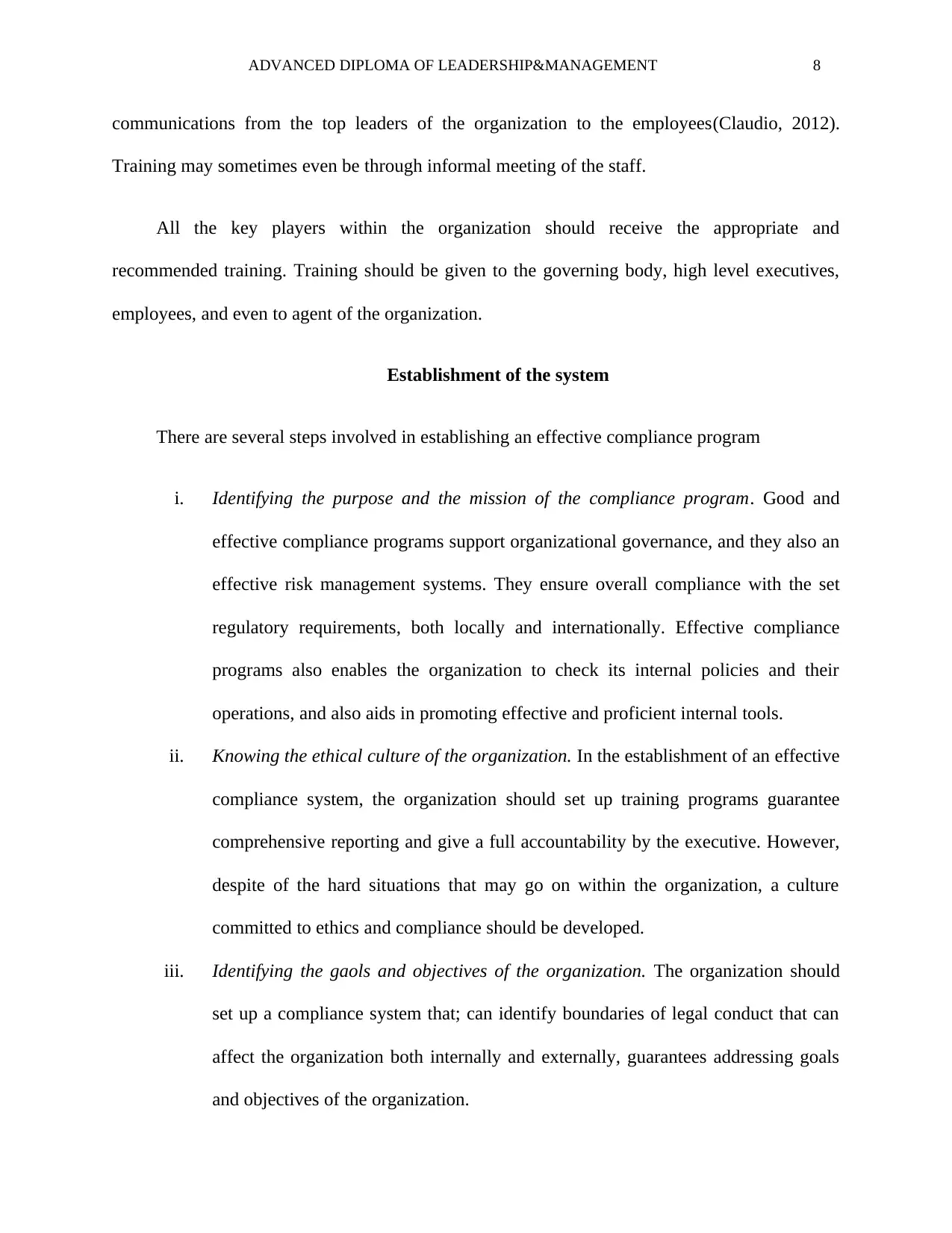
ADVANCED DIPLOMA OF LEADERSHIP&MANAGEMENT 8
communications from the top leaders of the organization to the employees(Claudio, 2012).
Training may sometimes even be through informal meeting of the staff.
All the key players within the organization should receive the appropriate and
recommended training. Training should be given to the governing body, high level executives,
employees, and even to agent of the organization.
Establishment of the system
There are several steps involved in establishing an effective compliance program
i. Identifying the purpose and the mission of the compliance program. Good and
effective compliance programs support organizational governance, and they also an
effective risk management systems. They ensure overall compliance with the set
regulatory requirements, both locally and internationally. Effective compliance
programs also enables the organization to check its internal policies and their
operations, and also aids in promoting effective and proficient internal tools.
ii. Knowing the ethical culture of the organization. In the establishment of an effective
compliance system, the organization should set up training programs guarantee
comprehensive reporting and give a full accountability by the executive. However,
despite of the hard situations that may go on within the organization, a culture
committed to ethics and compliance should be developed.
iii. Identifying the gaols and objectives of the organization. The organization should
set up a compliance system that; can identify boundaries of legal conduct that can
affect the organization both internally and externally, guarantees addressing goals
and objectives of the organization.
communications from the top leaders of the organization to the employees(Claudio, 2012).
Training may sometimes even be through informal meeting of the staff.
All the key players within the organization should receive the appropriate and
recommended training. Training should be given to the governing body, high level executives,
employees, and even to agent of the organization.
Establishment of the system
There are several steps involved in establishing an effective compliance program
i. Identifying the purpose and the mission of the compliance program. Good and
effective compliance programs support organizational governance, and they also an
effective risk management systems. They ensure overall compliance with the set
regulatory requirements, both locally and internationally. Effective compliance
programs also enables the organization to check its internal policies and their
operations, and also aids in promoting effective and proficient internal tools.
ii. Knowing the ethical culture of the organization. In the establishment of an effective
compliance system, the organization should set up training programs guarantee
comprehensive reporting and give a full accountability by the executive. However,
despite of the hard situations that may go on within the organization, a culture
committed to ethics and compliance should be developed.
iii. Identifying the gaols and objectives of the organization. The organization should
set up a compliance system that; can identify boundaries of legal conduct that can
affect the organization both internally and externally, guarantees addressing goals
and objectives of the organization.
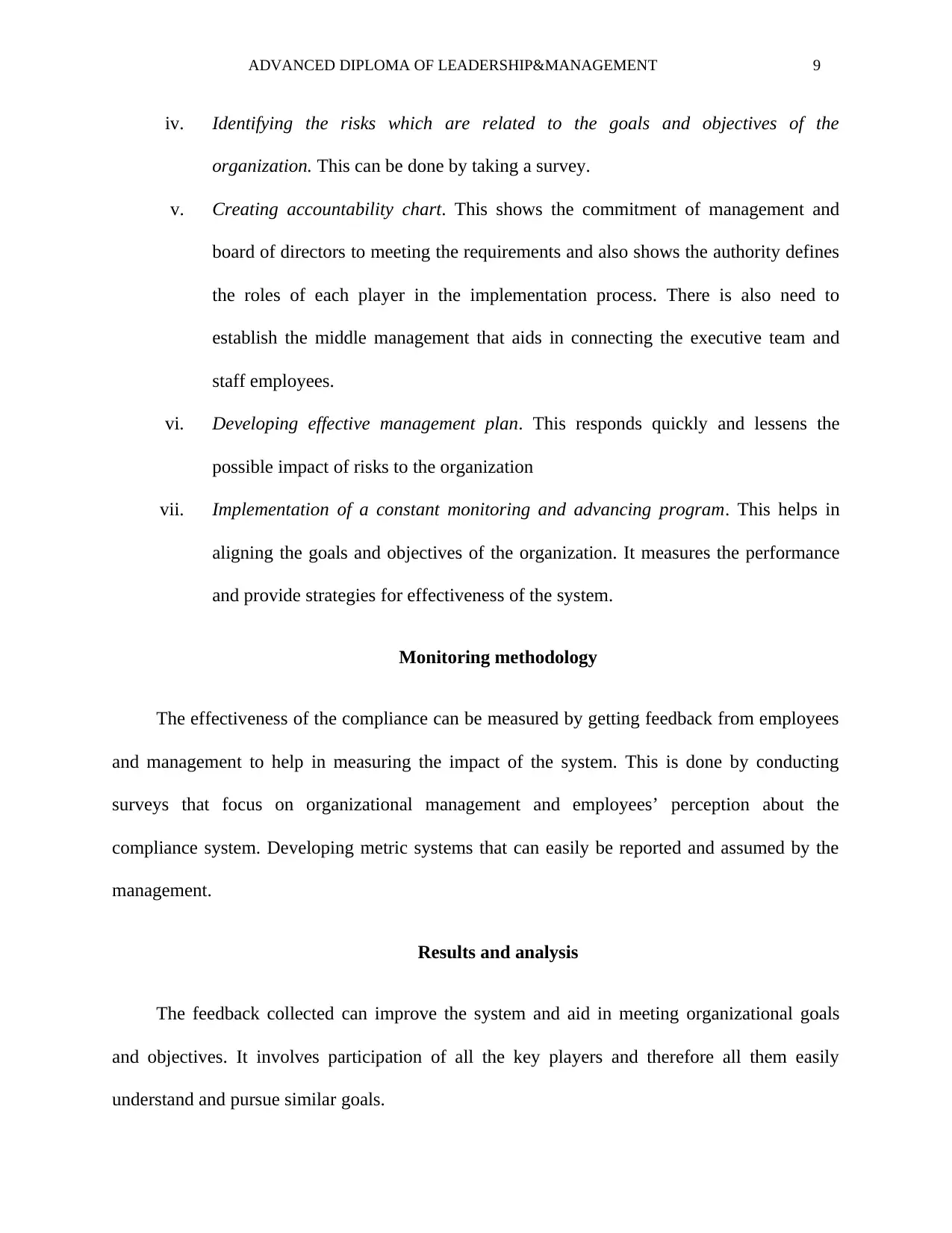
ADVANCED DIPLOMA OF LEADERSHIP&MANAGEMENT 9
iv. Identifying the risks which are related to the goals and objectives of the
organization. This can be done by taking a survey.
v. Creating accountability chart. This shows the commitment of management and
board of directors to meeting the requirements and also shows the authority defines
the roles of each player in the implementation process. There is also need to
establish the middle management that aids in connecting the executive team and
staff employees.
vi. Developing effective management plan. This responds quickly and lessens the
possible impact of risks to the organization
vii. Implementation of a constant monitoring and advancing program. This helps in
aligning the goals and objectives of the organization. It measures the performance
and provide strategies for effectiveness of the system.
Monitoring methodology
The effectiveness of the compliance can be measured by getting feedback from employees
and management to help in measuring the impact of the system. This is done by conducting
surveys that focus on organizational management and employees’ perception about the
compliance system. Developing metric systems that can easily be reported and assumed by the
management.
Results and analysis
The feedback collected can improve the system and aid in meeting organizational goals
and objectives. It involves participation of all the key players and therefore all them easily
understand and pursue similar goals.
iv. Identifying the risks which are related to the goals and objectives of the
organization. This can be done by taking a survey.
v. Creating accountability chart. This shows the commitment of management and
board of directors to meeting the requirements and also shows the authority defines
the roles of each player in the implementation process. There is also need to
establish the middle management that aids in connecting the executive team and
staff employees.
vi. Developing effective management plan. This responds quickly and lessens the
possible impact of risks to the organization
vii. Implementation of a constant monitoring and advancing program. This helps in
aligning the goals and objectives of the organization. It measures the performance
and provide strategies for effectiveness of the system.
Monitoring methodology
The effectiveness of the compliance can be measured by getting feedback from employees
and management to help in measuring the impact of the system. This is done by conducting
surveys that focus on organizational management and employees’ perception about the
compliance system. Developing metric systems that can easily be reported and assumed by the
management.
Results and analysis
The feedback collected can improve the system and aid in meeting organizational goals
and objectives. It involves participation of all the key players and therefore all them easily
understand and pursue similar goals.
⊘ This is a preview!⊘
Do you want full access?
Subscribe today to unlock all pages.

Trusted by 1+ million students worldwide

ADVANCED DIPLOMA OF LEADERSHIP&MANAGEMENT 10
Conclusion
A regulatory compliance system is useful for any organization because it enables to handle
risks, promote transparency, improve accountability and to also to reduce compliance costs.
Adhering to the organizational requirements does not only improve reputation but also leads the
organization to attaining its set objectives.
Therefore, organizations should review their external, internal and industrial compliance
requirements so as to improve their performance.
Conclusion
A regulatory compliance system is useful for any organization because it enables to handle
risks, promote transparency, improve accountability and to also to reduce compliance costs.
Adhering to the organizational requirements does not only improve reputation but also leads the
organization to attaining its set objectives.
Therefore, organizations should review their external, internal and industrial compliance
requirements so as to improve their performance.
Paraphrase This Document
Need a fresh take? Get an instant paraphrase of this document with our AI Paraphraser
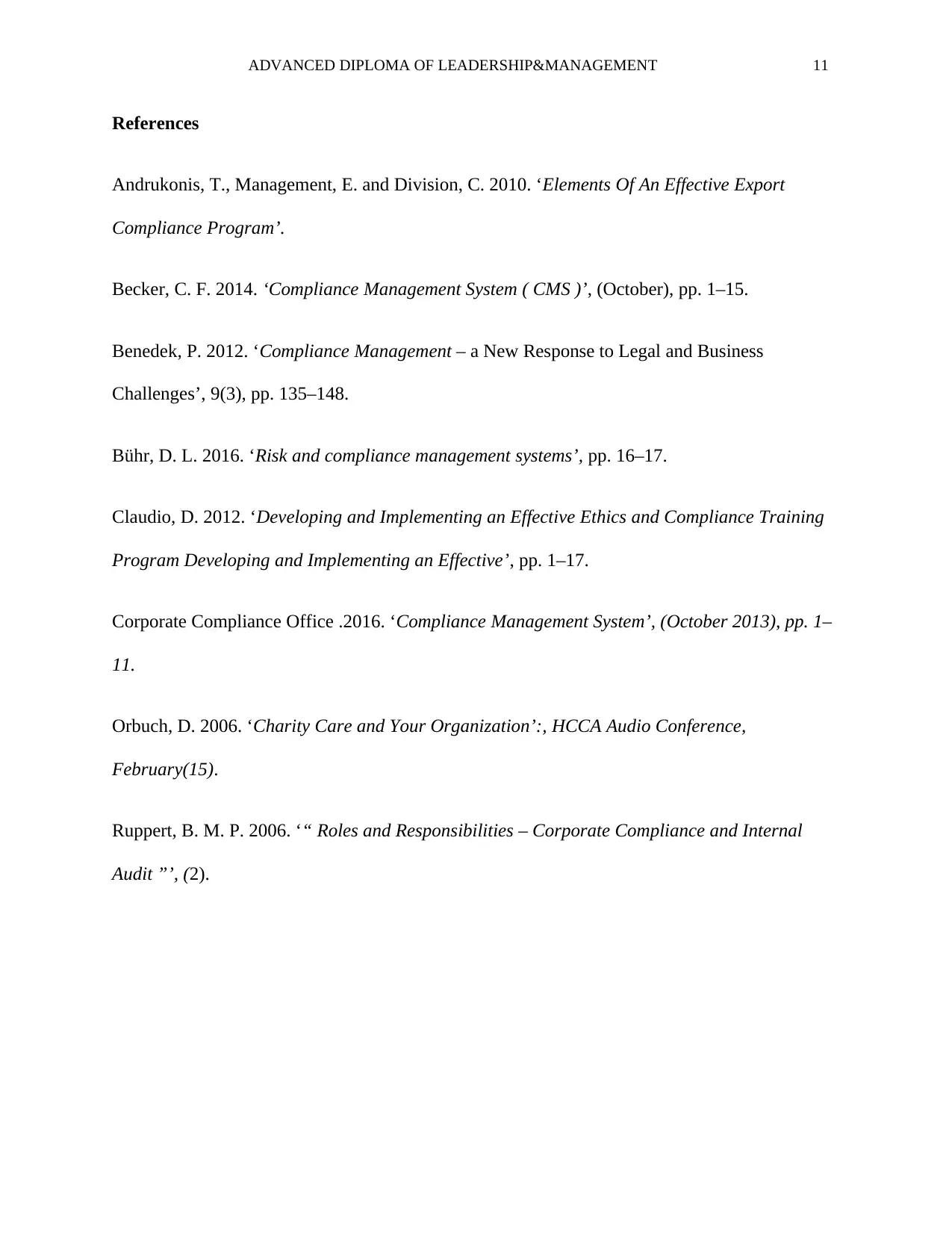
ADVANCED DIPLOMA OF LEADERSHIP&MANAGEMENT 11
References
Andrukonis, T., Management, E. and Division, C. 2010. ‘Elements Of An Effective Export
Compliance Program’.
Becker, C. F. 2014. ‘Compliance Management System ( CMS )’, (October), pp. 1–15.
Benedek, P. 2012. ‘Compliance Management – a New Response to Legal and Business
Challenges’, 9(3), pp. 135–148.
Bühr, D. L. 2016. ‘Risk and compliance management systems’, pp. 16–17.
Claudio, D. 2012. ‘Developing and Implementing an Effective Ethics and Compliance Training
Program Developing and Implementing an Effective’, pp. 1–17.
Corporate Compliance Office .2016. ‘Compliance Management System’, (October 2013), pp. 1–
11.
Orbuch, D. 2006. ‘Charity Care and Your Organization’:, HCCA Audio Conference,
February(15).
Ruppert, B. M. P. 2006. ‘“ Roles and Responsibilities – Corporate Compliance and Internal
Audit ”’, (2).
References
Andrukonis, T., Management, E. and Division, C. 2010. ‘Elements Of An Effective Export
Compliance Program’.
Becker, C. F. 2014. ‘Compliance Management System ( CMS )’, (October), pp. 1–15.
Benedek, P. 2012. ‘Compliance Management – a New Response to Legal and Business
Challenges’, 9(3), pp. 135–148.
Bühr, D. L. 2016. ‘Risk and compliance management systems’, pp. 16–17.
Claudio, D. 2012. ‘Developing and Implementing an Effective Ethics and Compliance Training
Program Developing and Implementing an Effective’, pp. 1–17.
Corporate Compliance Office .2016. ‘Compliance Management System’, (October 2013), pp. 1–
11.
Orbuch, D. 2006. ‘Charity Care and Your Organization’:, HCCA Audio Conference,
February(15).
Ruppert, B. M. P. 2006. ‘“ Roles and Responsibilities – Corporate Compliance and Internal
Audit ”’, (2).
1 out of 11
Related Documents
Your All-in-One AI-Powered Toolkit for Academic Success.
+13062052269
info@desklib.com
Available 24*7 on WhatsApp / Email
![[object Object]](/_next/static/media/star-bottom.7253800d.svg)
Unlock your academic potential
Copyright © 2020–2025 A2Z Services. All Rights Reserved. Developed and managed by ZUCOL.





